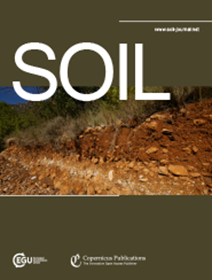加拿大波弗特海岸土壤有机碳和氮储量的区域综合与绘图
IF 4.3
2区 农林科学
Q1 SOIL SCIENCE
引用次数: 0
摘要
摘要。永久冻土特别容易受到气候变化的影响。为了评估和改进碳(C)和氮(N)的估算,有必要对多年冻土区的土壤碳和氮进行准确的测绘。特别是,从局部到泛北极尺度的土壤有机碳储量已经被许多研究预测和绘制。在加拿大波弗特海沿岸进行了几项研究,但尚未进行基于空间模拟的陆地碳储量区域合成。本研究综合了加拿大沿海平原的现有野外数据,并利用机器学习算法随机森林和基于遥感数据的环境变量,将其用于绘制区域SOC和N储量。我们探讨了土壤性质的局部差异,以及土壤数据分布如何影响土壤有机碳和氮储量预测的准确性。我们绘制了整个区域的有机碳和氮储量图,并建立了沿海大陆地区和齐齐克塔鲁克赫歇尔岛的独立模型。采用适用面积法(Area of Applicability, AOA)对不同随机森林模型的性能进行了评价。我们进一步将分位数回归森林方法应用于大陆和齐齐克塔鲁克赫歇尔岛碳储量模型,并与AOA方法进行了比较。我们的结果表明,不仅数据的选择对生成的地图至关重要,而且所选择的协变量也是最重要的,这些协变量是由模型挑选出来的。上层土壤有机碳储量为56.7±5.6 kg m−2,氮储量为2.19±0.51 kg m−2。当包括或不包括预测模型中的数据时,平均SOC库存变化很大。齐齐克塔鲁克赫歇尔岛地质上与沿海大陆不同,有机碳储量较低。包括齐齐克塔鲁克赫歇尔岛土壤数据对大陆土壤有机碳储量预测结果影响较大。氮储量的差异不像有机碳储量那样依赖于地理位置,而是在个体研究之间存在差异。结果表明,齐齐克塔鲁克赫舍尔岛为36.2±5.7 kg C m−2和2.66±0.39 kg N m−2,大陆为57.2±4.5 kg C m−2和2.17±0.50 kg N m−2。我们的研究结果不同于以往的低分辨率研究,表明在中等分辨率和足够的野外数据下可以实现更高的区域尺度精度和精度。本文章由计算机程序翻译,如有差异,请以英文原文为准。
Regional synthesis and mapping of soil organic carbon and nitrogen stocks at the Canadian Beaufort coast
Abstract. Permafrost soils are particularly vulnerable to climate change. To assess and improve estimations of carbon (C) and nitrogen (N) budgets it is necessary to accurately map soil carbon and nitrogen in the permafrost region. In particular, soil organic carbon (SOC) stocks have been predicted and mapped by many studies from local to pan-Arctic scales. Several studies have been carried out at the Canadian Beaufort Sea coast, though no regional synthesis of terrestrial carbon stocks based on spatial modelling has been conducted yet. This study synthesises available field data from the Canadian coastal plain and uses it to map regional SOC and N stocks using the machine learning algorithm random forest and environmental variables based on remote sensing data. We explore local differences in soil properties and how soil data distribution across the region affects the accuracy of the predictions of SOC and N stocks. We mapped SOC and N stocks for the entire region and provide separate models for the coastal mainland area and Qikiqtaruk Herschel Island. We assessed performance of different random forest models by using the Area of Applicability (AOA) method. We further applied the quantile regression forest method to the mainland and Qikiqtaruk Herschel Island models for SOC stocks and compared the results with the AOA method. Our results indicate that not only the selection of data is crucial for the resulting maps, but also the chosen covariates, which were picked by the models as most important. The estimated SOC stock for the upper metre is 56.7 ± 5.6 kg m−2 and the N stock 2.19 ± 0.51 kg m−2. The average SOC stocks vary significantly when including or excluding data in the predictive models. Qikiqtaruk Herschel Island is geologically different from the coastal mainland and has lower SOC stocks. Including Qikiqtaruk Herschel Island soil data to predict SOC stocks at the mainland has large impact on the results. Differences in N stocks were not as dependent on the location as SOC stocks and rather differences between individual studies occurred. The results of the separate models show 36.2 ± 5.7 kg C m−2 and 2.66 ± 0.39 kg N m−2 for Qikiqtaruk Herschel Island and 57.2 ± 4.5 kg C m−2 and 2.17 ± 0.50 kg N m−2 for the mainland. Our results diverge from previous studies of lower resolution, showing the added regional-scale accuracy and precision that can be achieved at intermediate resolution and with sufficient field data.
求助全文
通过发布文献求助,成功后即可免费获取论文全文。
去求助
来源期刊

Soil
Agricultural and Biological Sciences-Soil Science
CiteScore
10.80
自引率
2.90%
发文量
44
审稿时长
30 weeks
期刊介绍:
SOIL is an international scientific journal dedicated to the publication and discussion of high-quality research in the field of soil system sciences.
SOIL is at the interface between the atmosphere, lithosphere, hydrosphere, and biosphere. SOIL publishes scientific research that contributes to understanding the soil system and its interaction with humans and the entire Earth system. The scope of the journal includes all topics that fall within the study of soil science as a discipline, with an emphasis on studies that integrate soil science with other sciences (hydrology, agronomy, socio-economics, health sciences, atmospheric sciences, etc.).
 求助内容:
求助内容: 应助结果提醒方式:
应助结果提醒方式:


